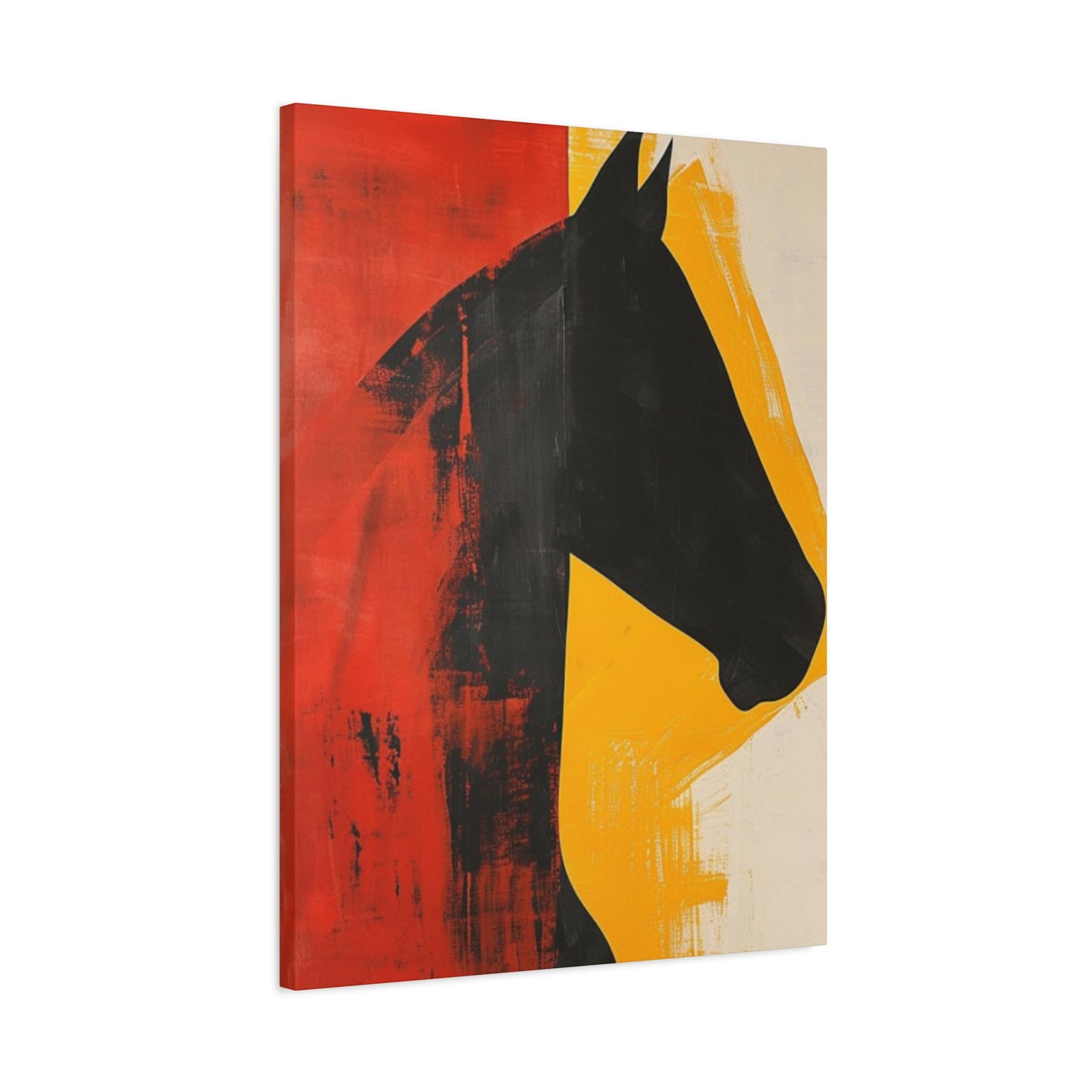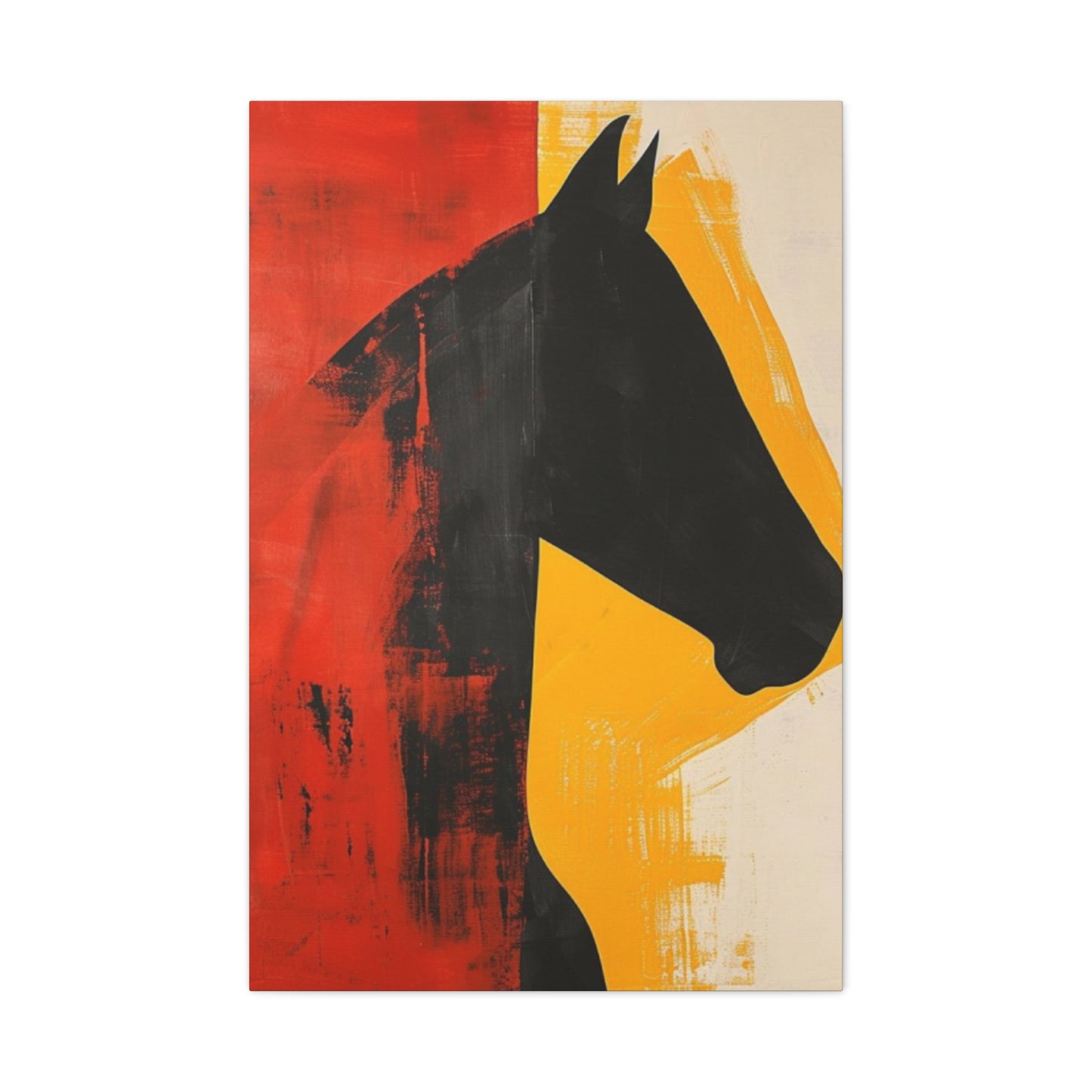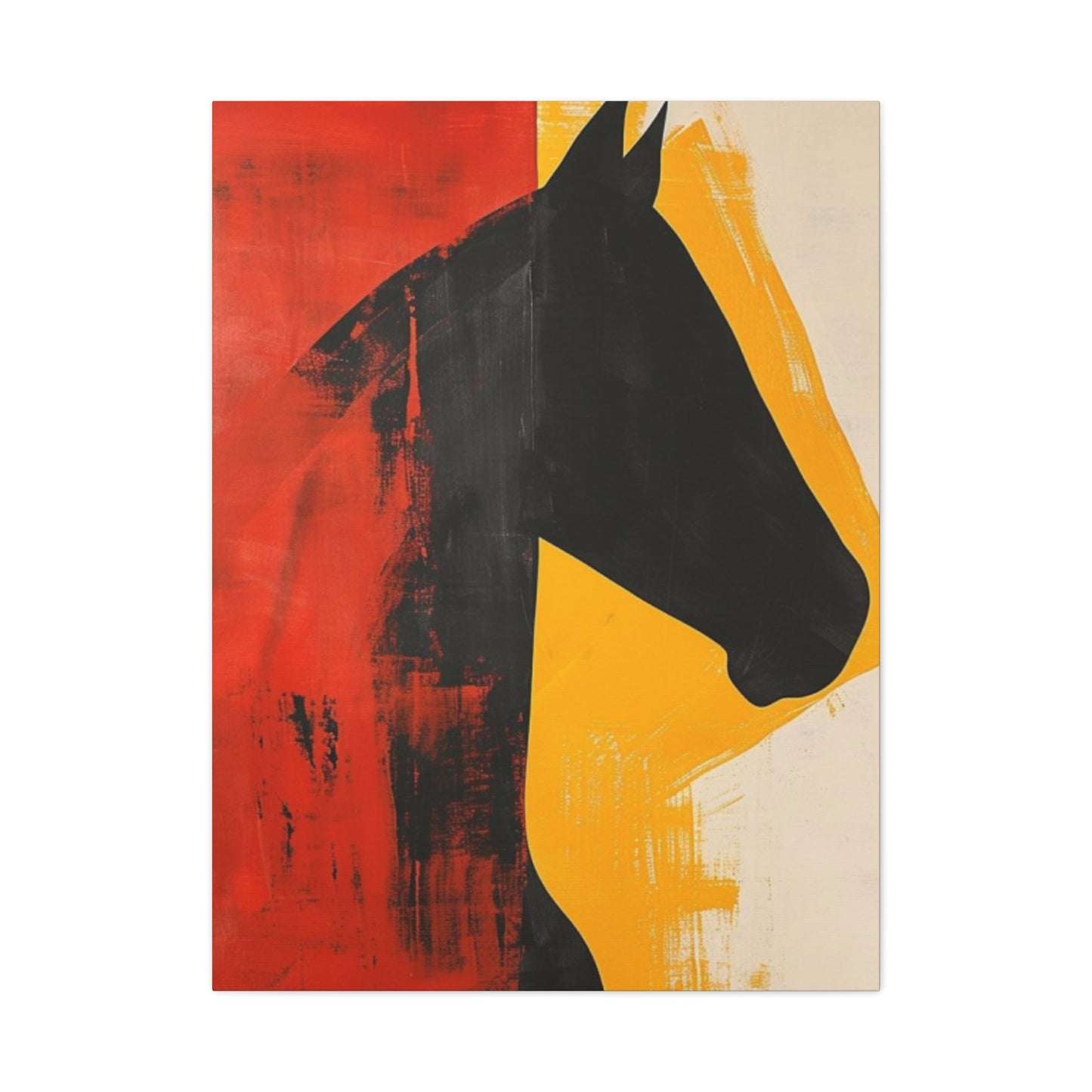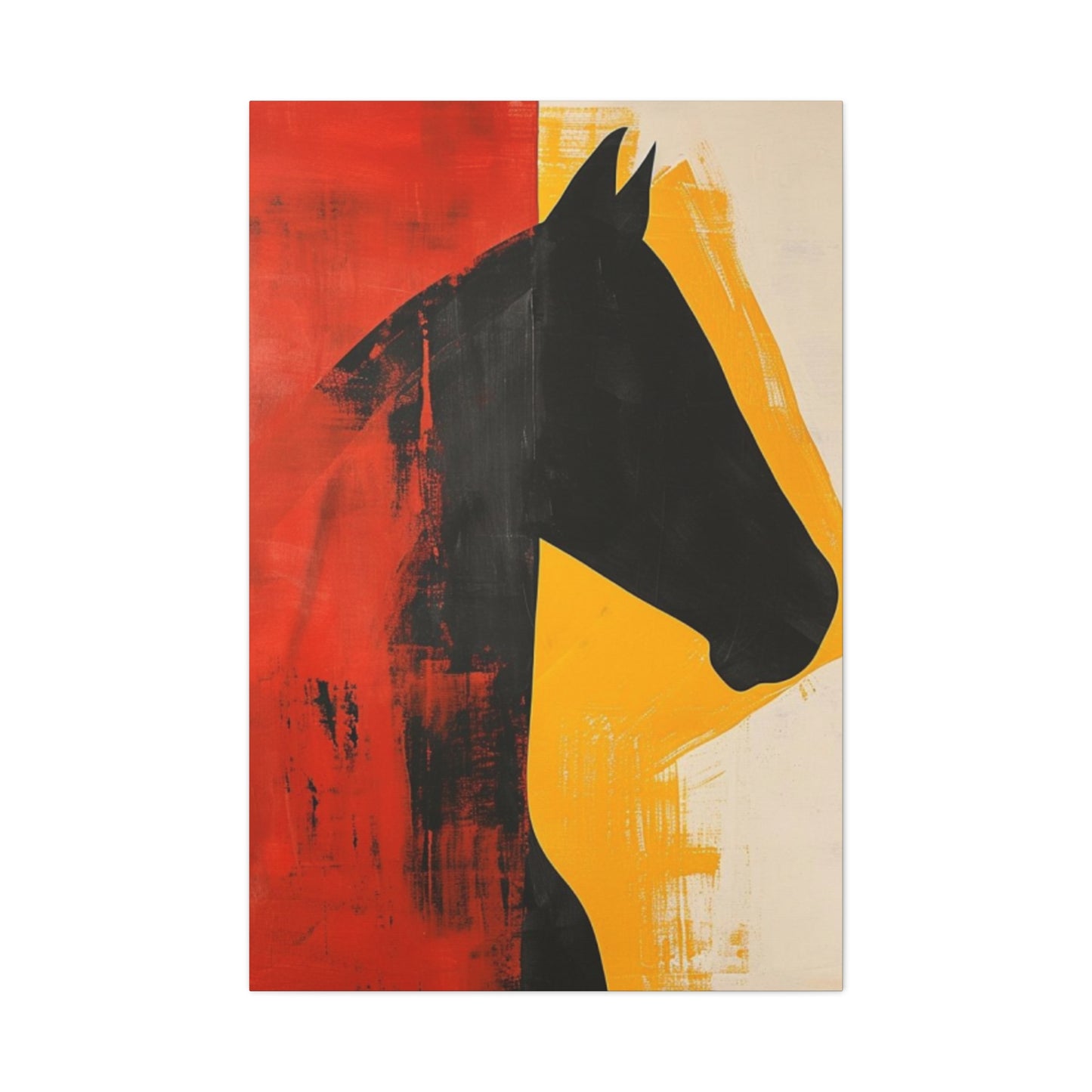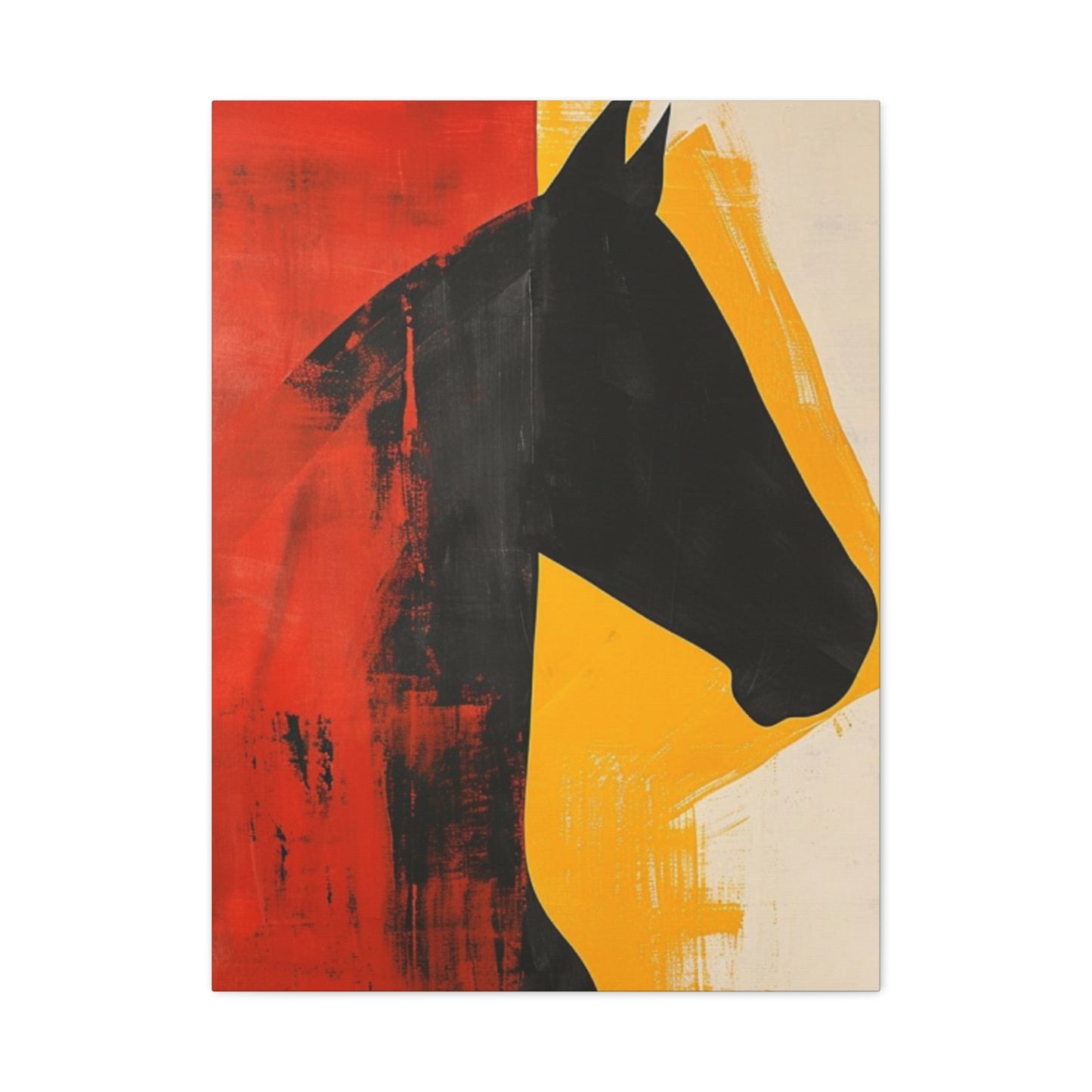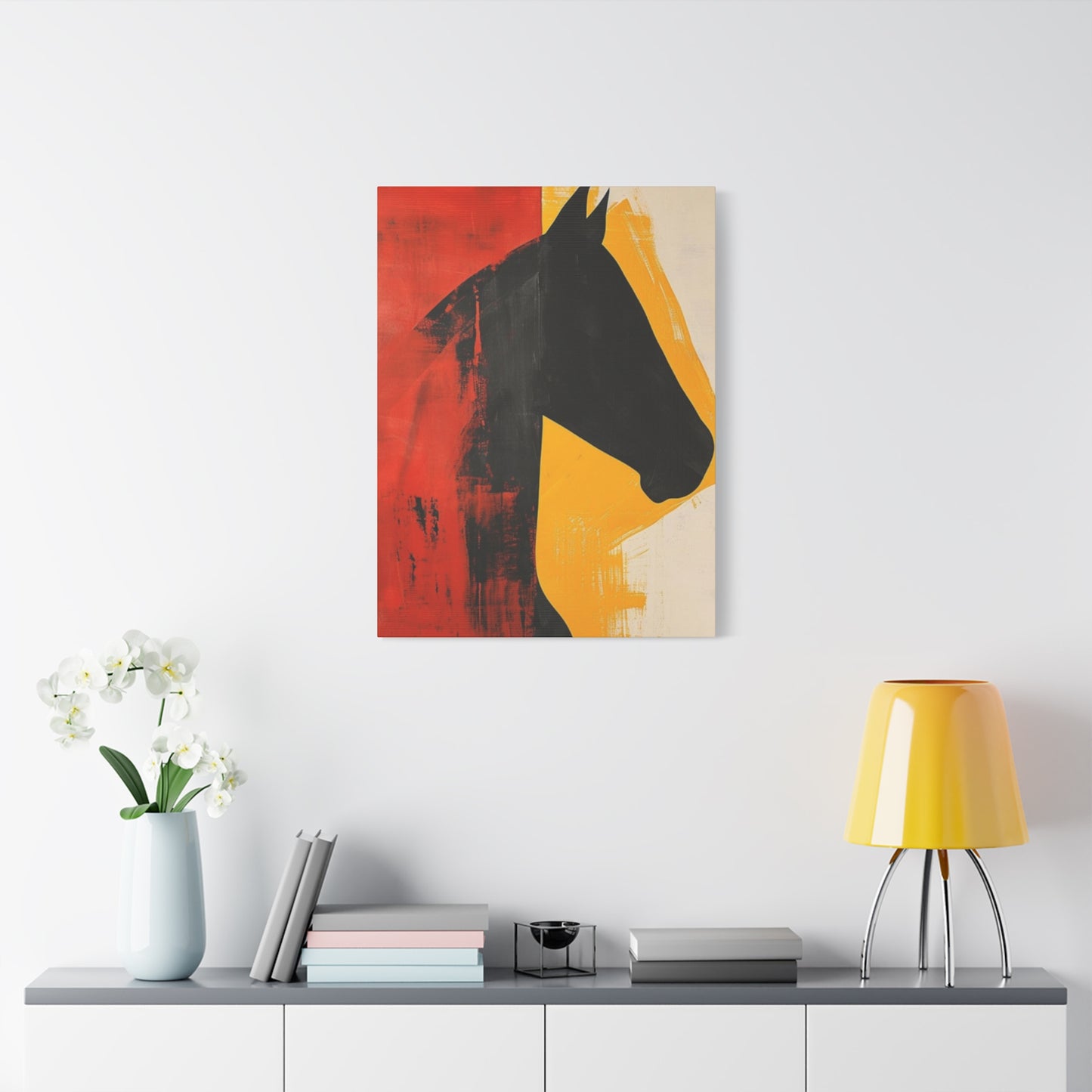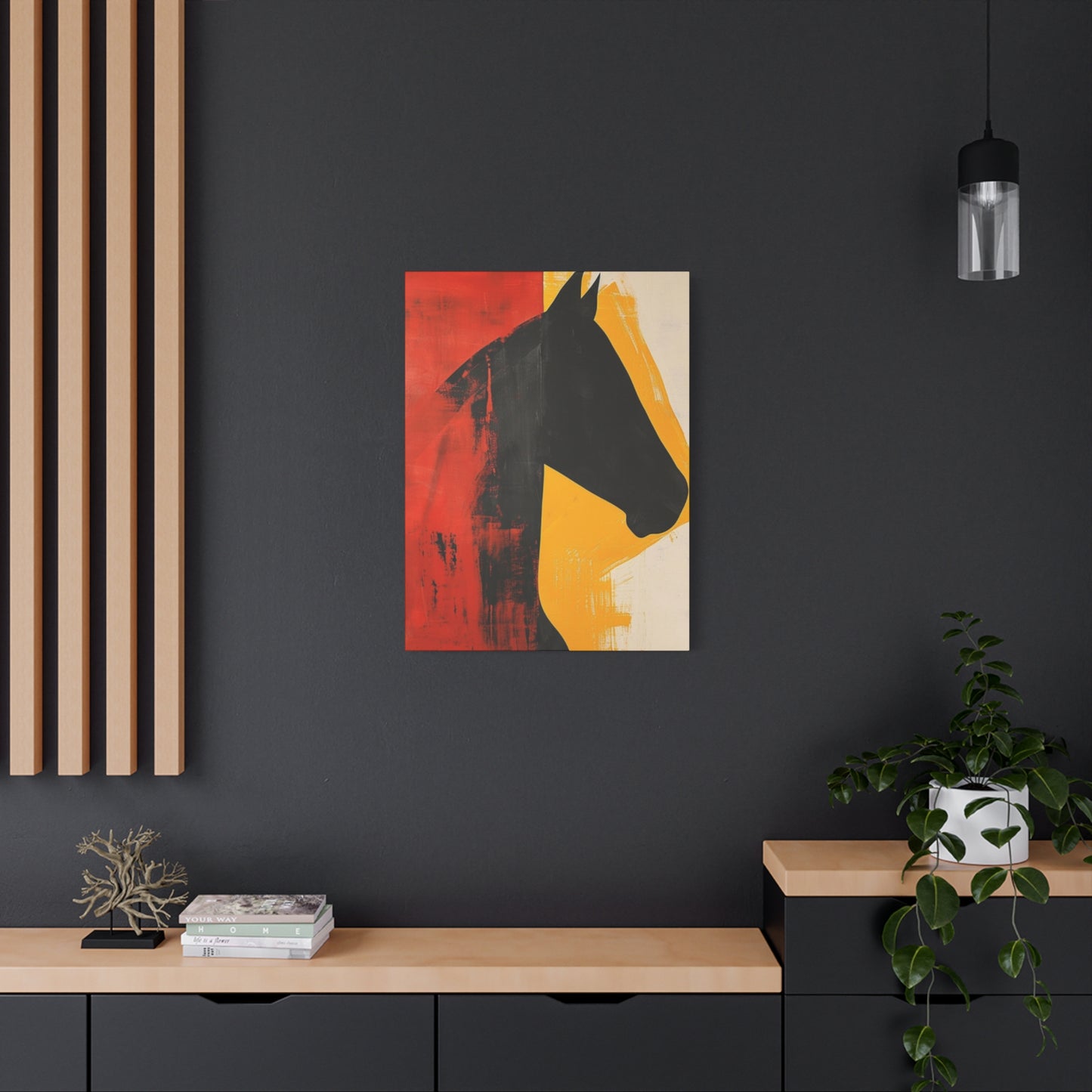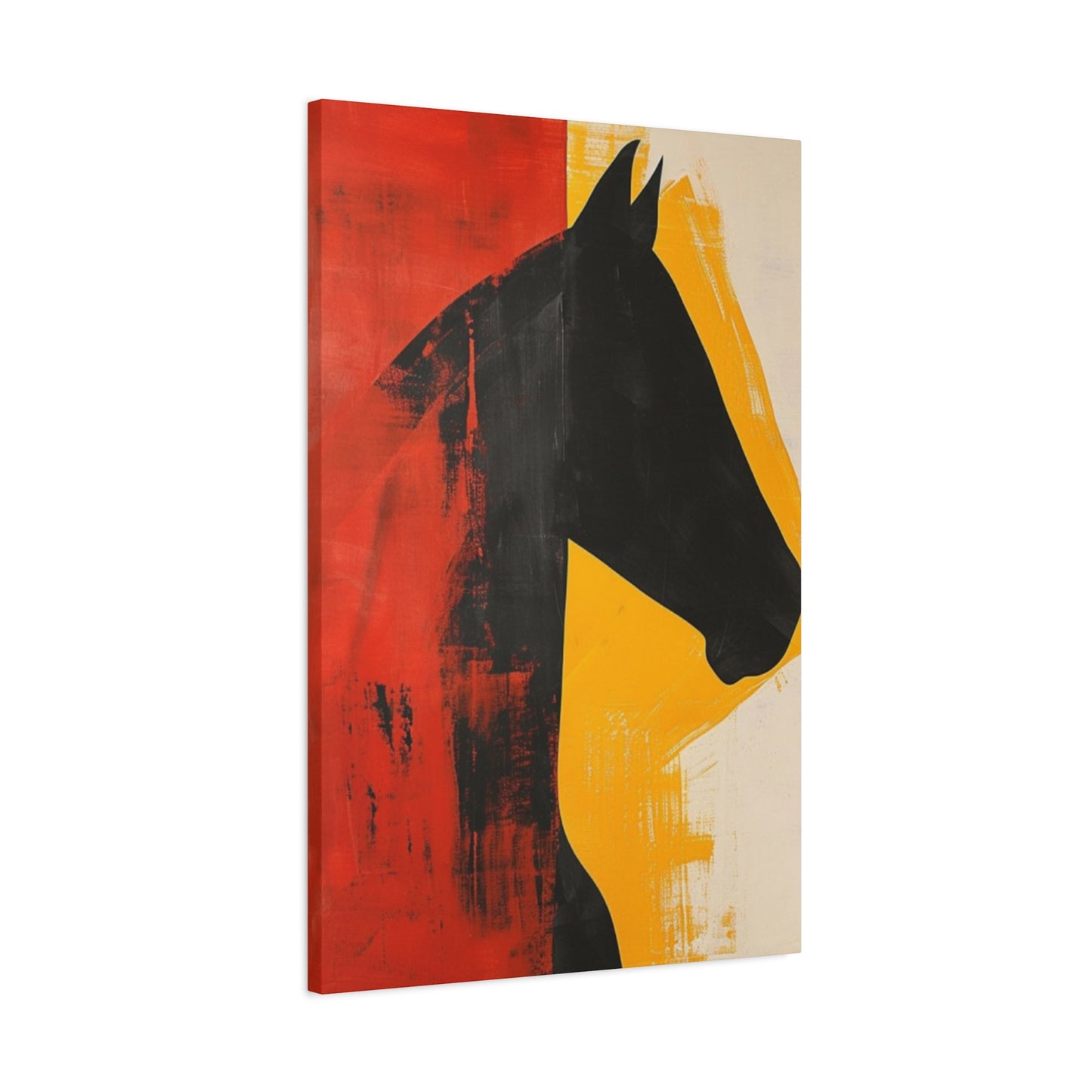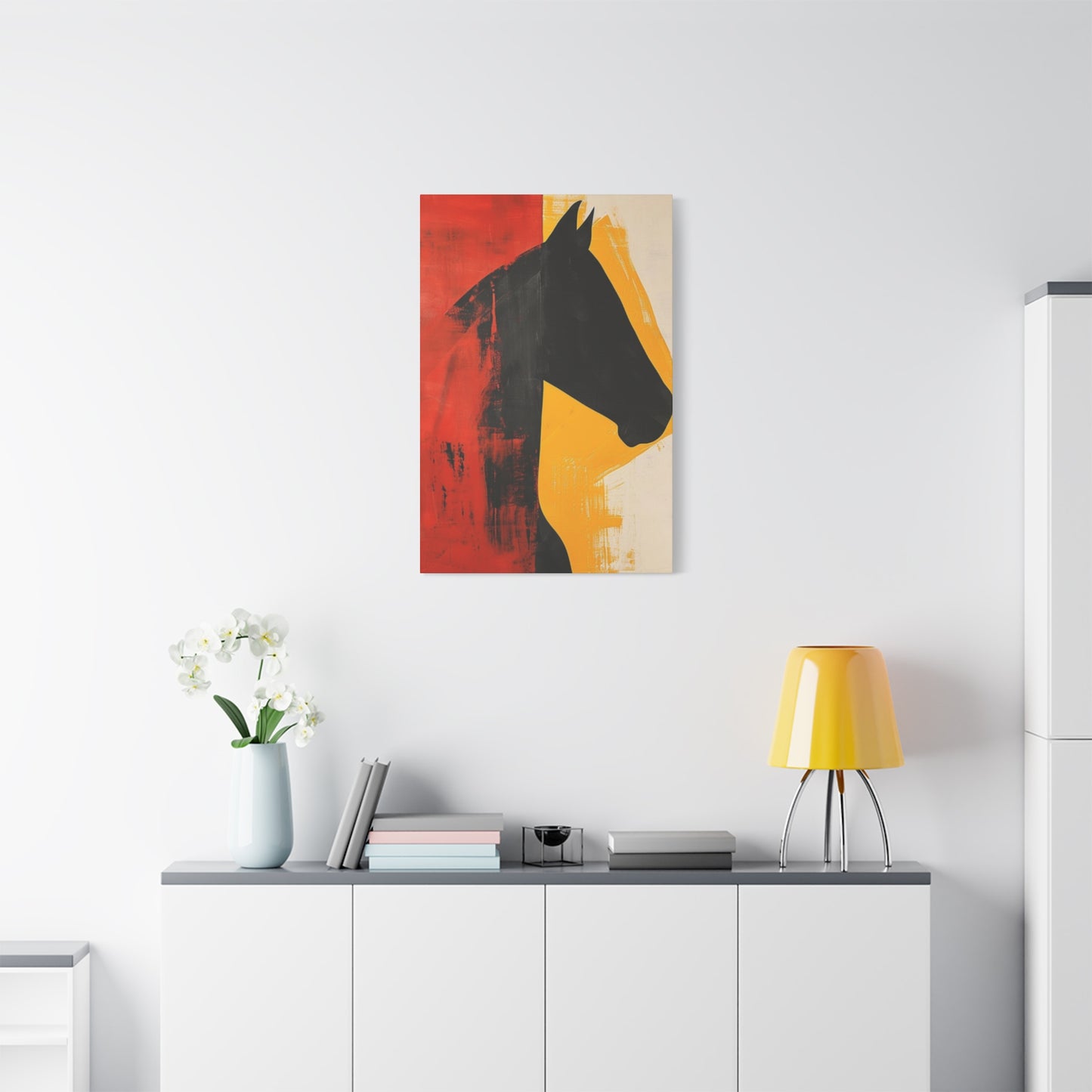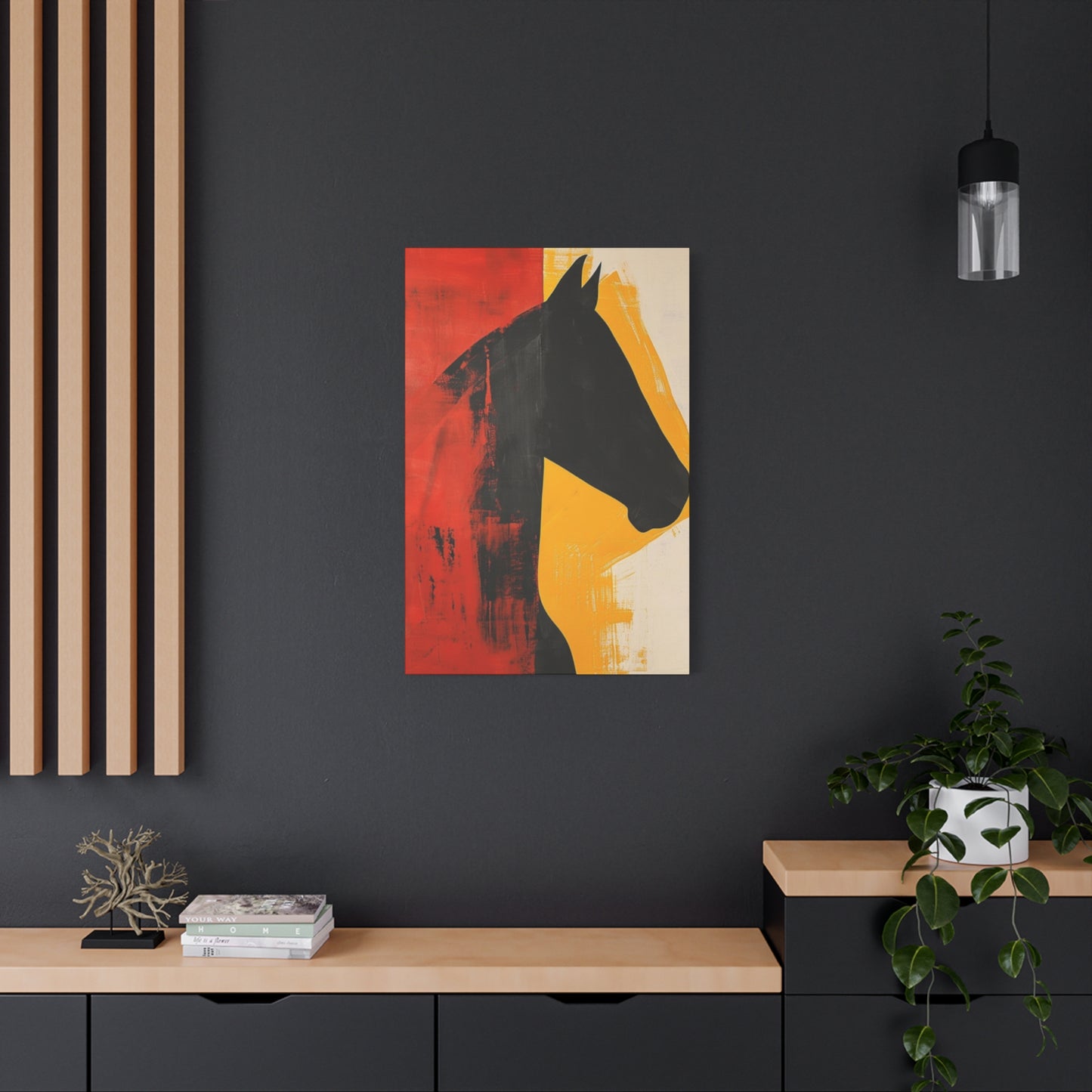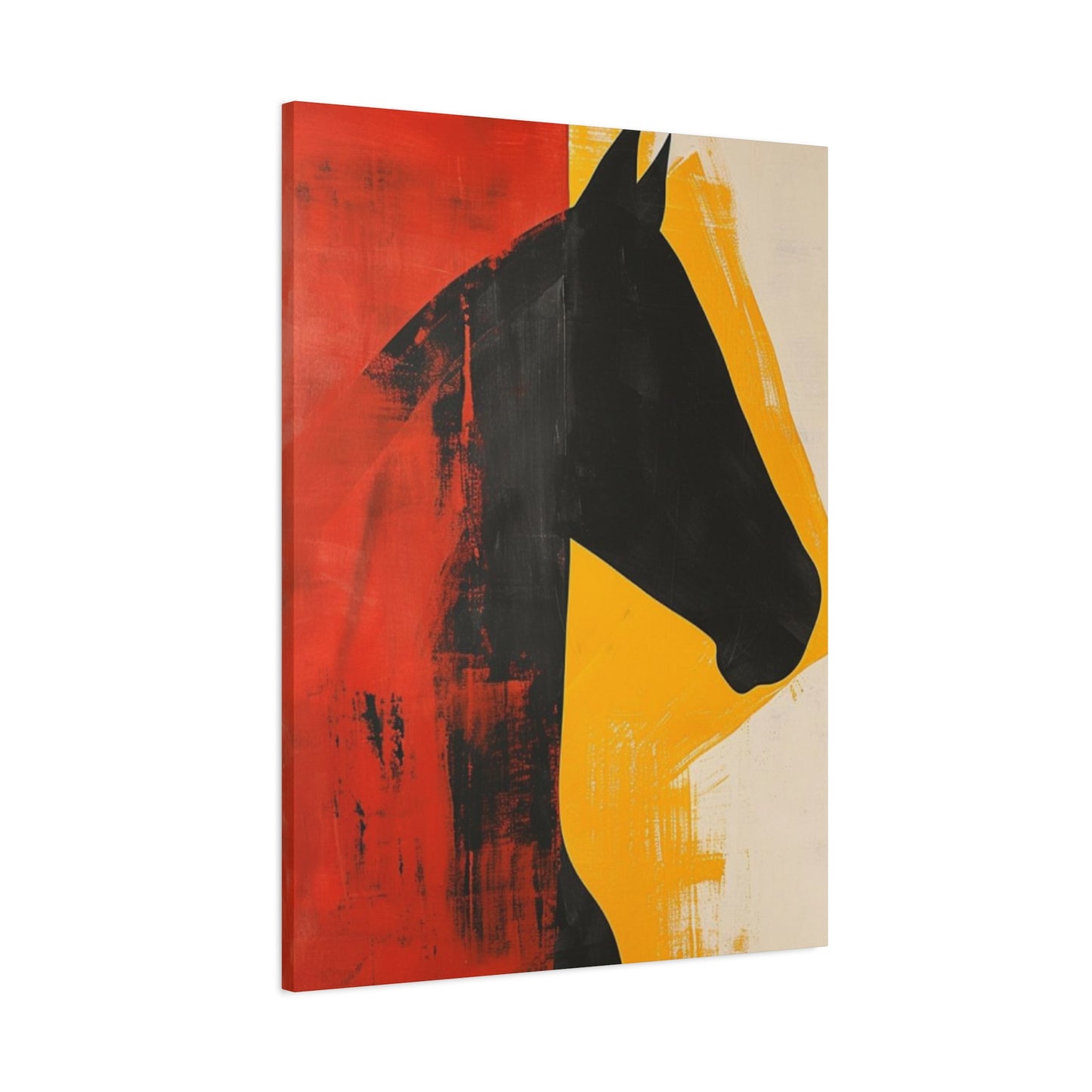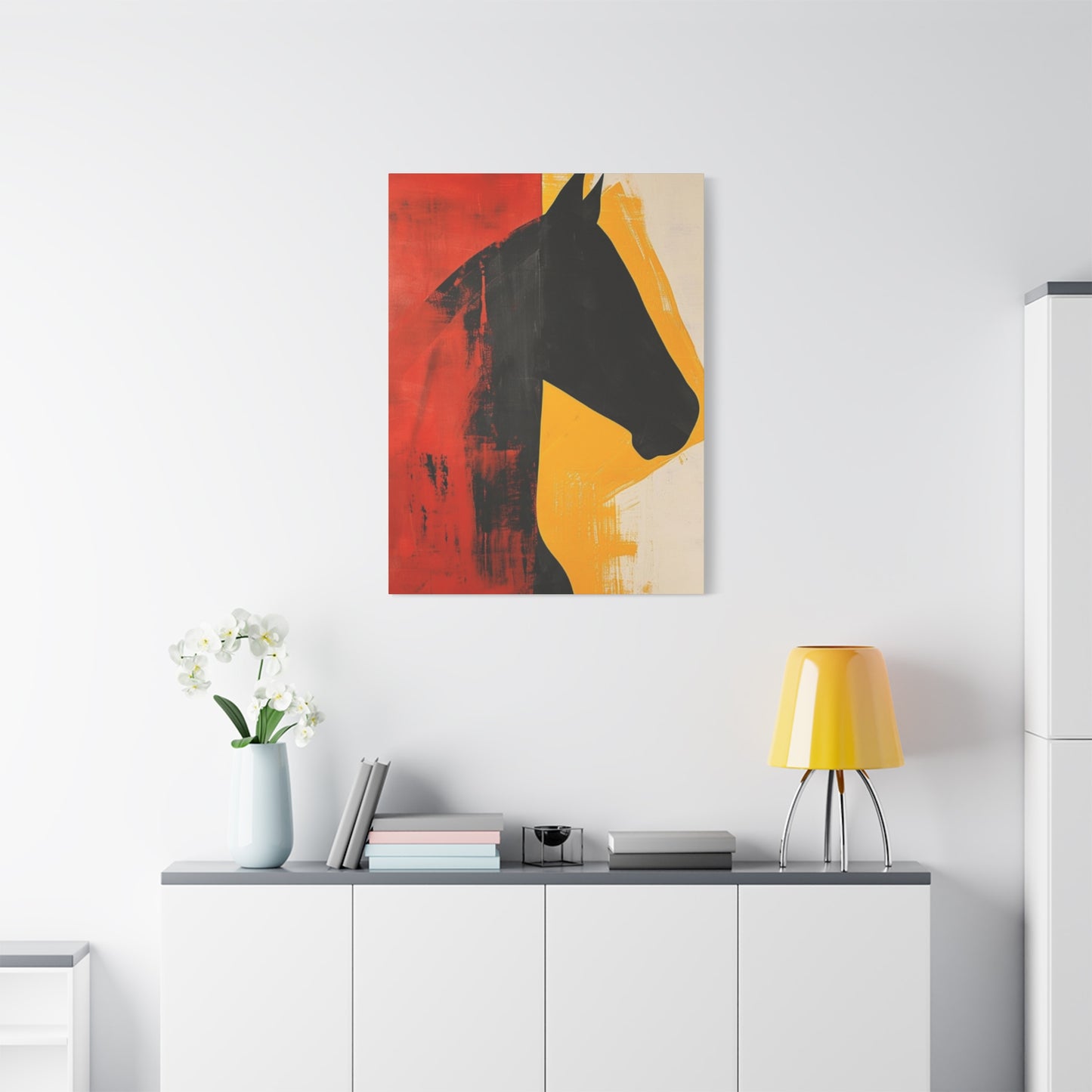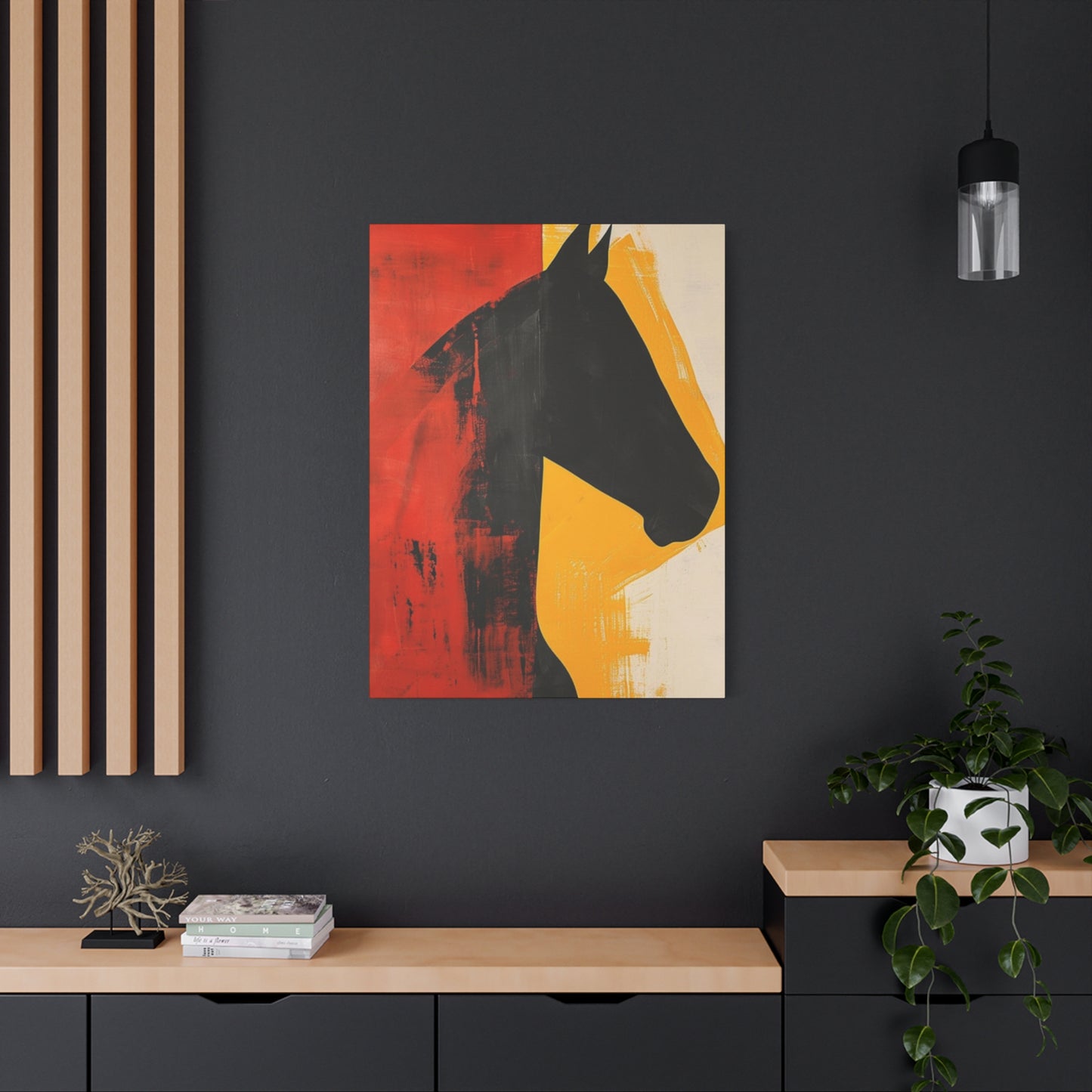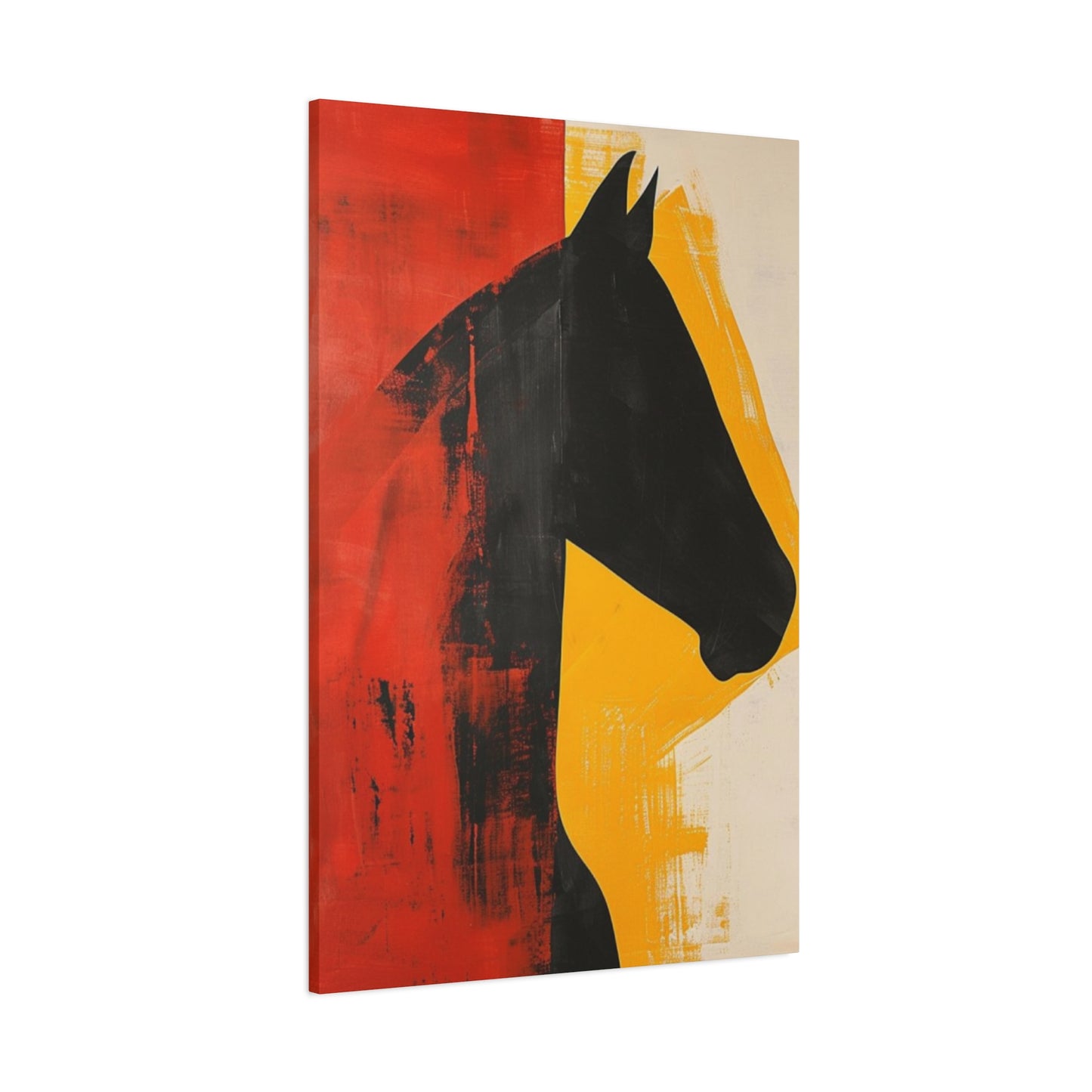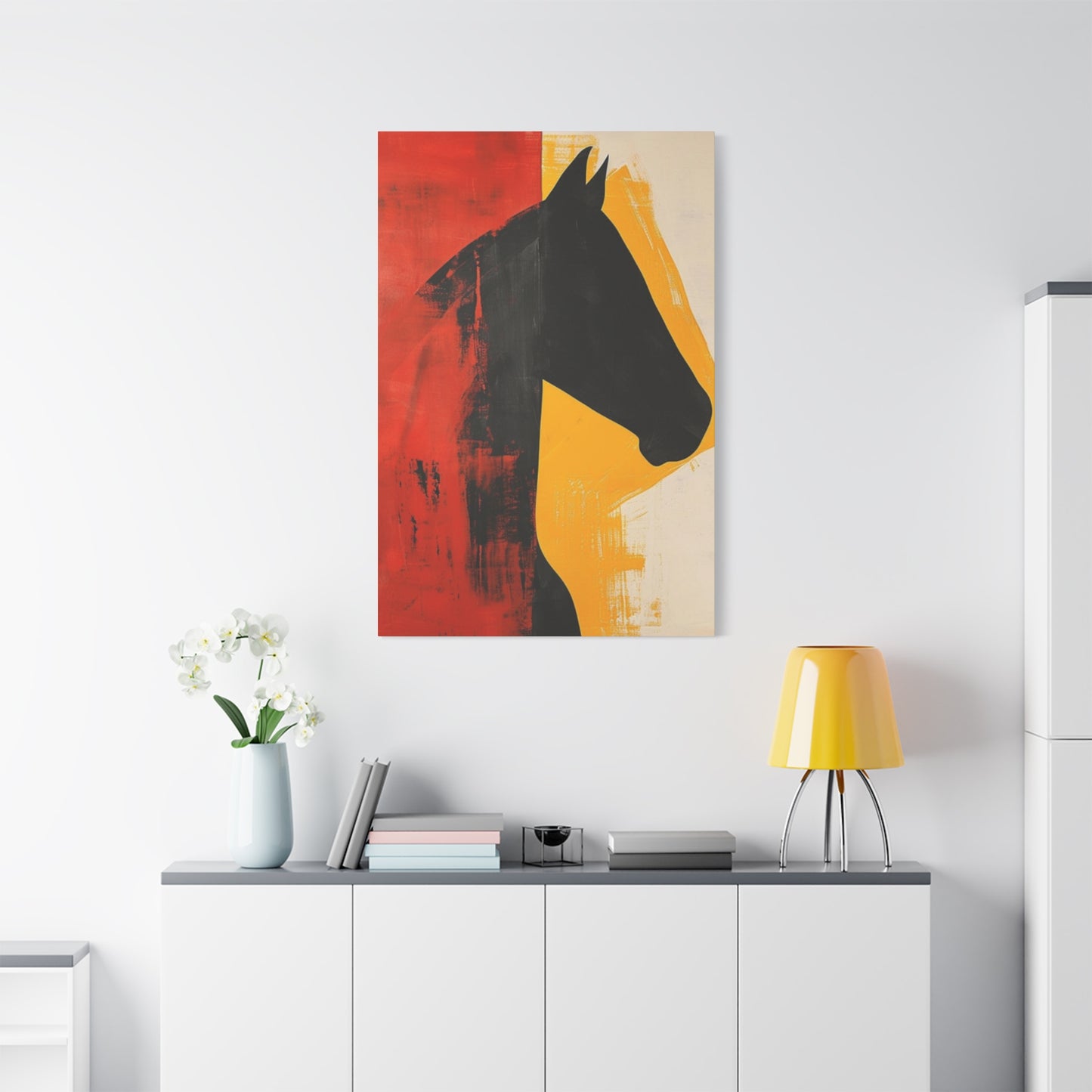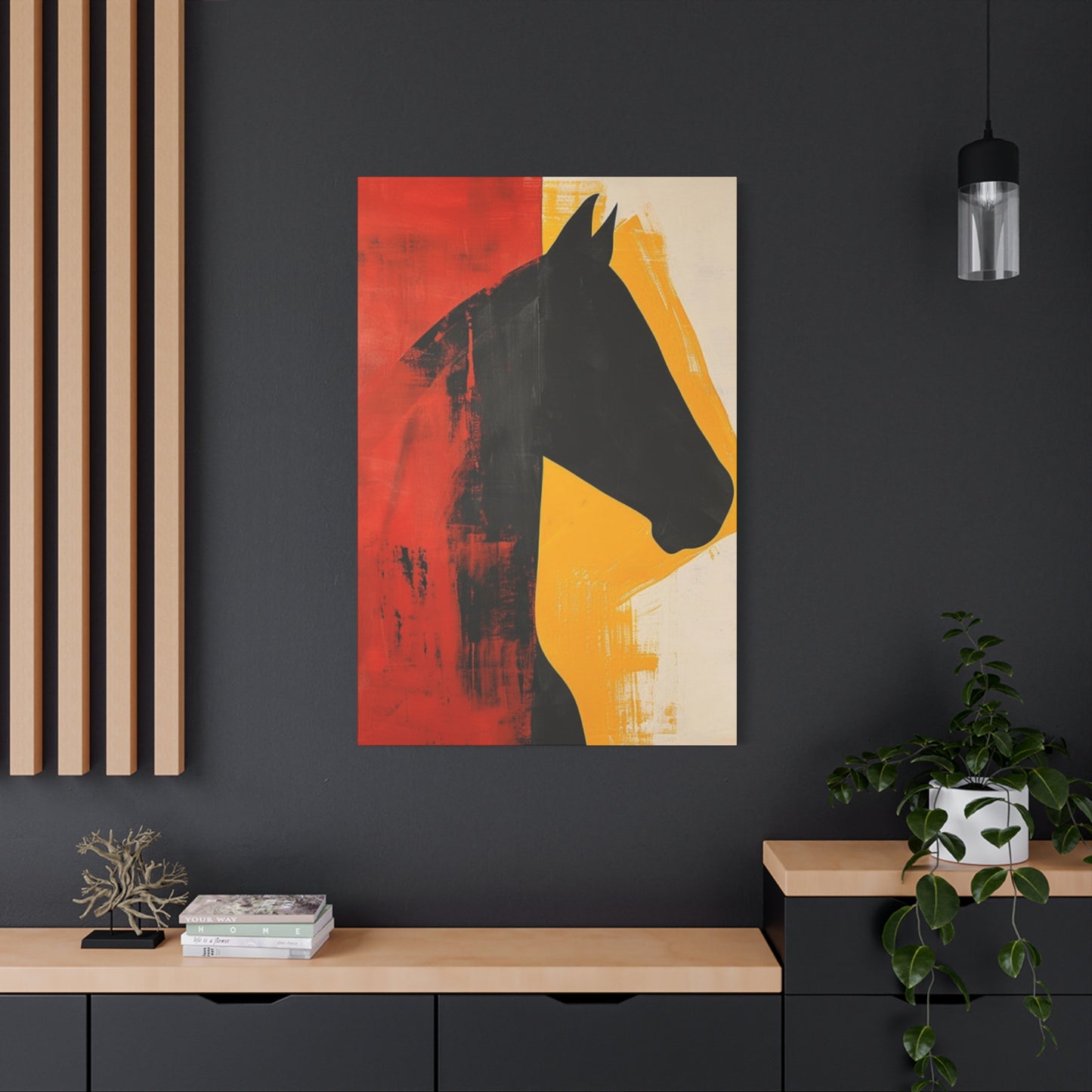Exploring Geometric Shapes in Horse Face Modernism Wall Art
The world of equine-inspired artwork has undergone a remarkable transformation, with horse face wall art emerging as a dominant force in contemporary home styling. This artistic movement represents more than mere decoration; it embodies a sophisticated blend of natural beauty, emotional resonance, and cutting-edge design principles that speak to our deepest connections with these magnificent creatures. The evolution of equine artwork has transcended traditional boundaries, creating pieces that serve as powerful focal points while simultaneously expressing the owner's aesthetic sensibilities and personal values.
Horse face wall art has become increasingly popular among homeowners, collectors, and design enthusiasts who seek to infuse their environments with both elegance and meaning. These pieces capture the essence of equine grace while adapting to modern sensibilities, creating a perfect marriage between timeless appeal and contemporary innovation. The artistic interpretations range from photorealistic portraits that showcase every detail of the horse's features to abstract representations that distill the animal's spirit into bold, expressive forms.
The significance of incorporating equine imagery into residential and commercial environments extends beyond aesthetic appeal. Horses have long symbolized freedom, strength, nobility, and spiritual connection across various cultures and historical periods. When translated into wall art, these symbolic meanings become integrated into the daily experience of those who encounter them, creating environments that inspire and uplift. The psychological impact of horse imagery has been documented in numerous studies, with many people reporting feelings of calm, inspiration, and connection to nature when surrounded by equine-themed artwork.
Contemporary artists and designers have embraced the challenge of reimagining horse face art for modern audiences, resulting in an explosion of creative approaches and stylistic innovations. From hyper-realistic digital paintings that capture every whisker and reflection in the animal's eyes to bold, geometric interpretations that reduce the horse's features to essential forms and colors, the range of available options ensures that there is something to suit every taste and decorating style.
The technical advancement in printing and reproduction technologies has also played a crucial role in making high-quality horse face wall art accessible to a broader audience. Museum-quality printing processes now allow for the creation of pieces that retain the vibrancy and detail of original artworks while being offered at price points that make them attainable for various budgets. This democratization of art has led to increased appreciation and adoption of equine-themed wall art across different demographics and economic segments.
Modern Horse Face Art
The realm of modern horse face art represents a fascinating convergence of traditional equine portraiture with contemporary artistic sensibilities and techniques. This genre has evolved significantly from classical horse paintings, embracing new materials, unconventional perspectives, and innovative approaches to color and form. Modern artists working in this field often challenge conventional representations of horses, choosing instead to explore the emotional and symbolic dimensions of these animals through their unique artistic lenses.
Contemporary horse face art frequently incorporates elements of surrealism, expressionism, and abstract art, creating pieces that transcend literal representation to explore deeper meanings and connections. Artists may exaggerate certain features of the horse's face, manipulate proportions, or introduce unexpected color palettes to achieve specific emotional or aesthetic effects. These creative liberties allow the artwork to function on multiple levels, serving both as decorative elements and as conversation pieces that invite contemplation and interpretation.
The use of mixed media has become increasingly prevalent in modern horse face art, with artists combining traditional painting techniques with digital elements, photographic components, and even three-dimensional elements. This approach creates layered, complex pieces that reward close examination and offer different experiences depending on viewing distance and lighting conditions. The integration of various media also allows artists to explore different textural qualities and visual effects that would be impossible to achieve through traditional painting alone.
Digital art has opened up entirely new possibilities for horse face art, enabling artists to create pieces with impossible color combinations, surreal lighting effects, and fantastical environments. Digital tools allow for precise manipulation of every aspect of the image, from the individual strands of the horse's mane to the reflection in its eyes. This level of control has enabled artists to create highly stylized, almost otherworldly representations of horses that capture their essential spirit while presenting them in ways that would be physically impossible to achieve through traditional photography or painting.
The modern horse face art movement has also been influenced by street art and urban culture, with some artists incorporating graffiti-style elements, bold typography, and industrial aesthetics into their equine portraits. This fusion creates pieces that feel both timeless and thoroughly contemporary, appealing to younger demographics while maintaining the universal appeal of horse imagery. The contrast between the noble, natural subject matter and the urban artistic treatment creates a dynamic tension that makes these pieces particularly engaging and memorable.
Installation and presentation have become integral aspects of modern horse face art, with many artists considering the relationship between the artwork and its environment as part of the creative process. Some pieces are designed to interact with specific lighting conditions or architectural elements, while others are created as part of larger installations that transform entire rooms or buildings. This holistic approach to art creation and presentation reflects the modern understanding of art as an experiential medium rather than simply a decorative object.
The influence of photography on modern horse face art cannot be overstated, with many contemporary pieces drawing inspiration from photographic techniques such as close-up cropping, unusual angles, and dramatic lighting. Some artists work directly with photographic source material, manipulating and transforming images to create new artistic statements. This photographic influence has led to a greater emphasis on capturing specific moments and expressions, resulting in pieces that feel alive and immediate.
Abstract Horse Faces
Abstract horse faces represent one of the most compelling and innovative directions in contemporary equine art, challenging viewers to engage with the essential spirit and energy of these magnificent animals rather than their literal appearance. This artistic approach strips away photographic realism to focus on the emotional and symbolic qualities that make horses such powerful subjects for artistic expression. Abstract horse face art operates on the principle that artistic truth can sometimes be more effectively communicated through suggestion and interpretation rather than precise representation.
The creation of abstract horse faces requires artists to develop a deep understanding of equine anatomy and character, as successful abstraction depends on identifying and emphasizing the most essential and recognizable elements. Artists must determine which features are most crucial for maintaining the horse's identity while eliminating or transforming others to achieve their artistic goals. This process of selection and emphasis creates pieces that can be simultaneously familiar and surprising, offering viewers both recognition and discovery.
Color plays a particularly important role in abstract horse face art, often carrying emotional and symbolic weight that extends far beyond natural representation. Artists may choose to work with naturalistic earth tones that evoke the horse's connection to the natural world, or they might embrace bold, unexpected color palettes that challenge conventional perceptions and create new associations. The strategic use of color can transform a simple horse face into a powerful statement about energy, emotion, or spiritual significance.
Texture and brushwork become especially significant in abstract horse face art, as these elements must carry much of the expressive weight that would normally be conveyed through detailed representation. Artists may use bold, gestural brushstrokes to suggest the horse's mane or employ subtle color gradations to imply the animal's muscular structure. The physical act of painting becomes visible in the finished work, adding an additional layer of human expression to the artistic interpretation of the animal subject.
The compositional freedom offered by abstract approaches allows artists to experiment with unconventional arrangements and perspectives that would be impossible or undesirable in realistic portraiture. Abstract horse faces might be fragmented across multiple panels, combined with geometric elements, or integrated into larger abstract compositions. This flexibility enables artists to create pieces that function as both equine portraits and pure abstract art, appealing to different aspects of viewer appreciation and understanding.
Many abstract horse face artists draw inspiration from various cultural and artistic traditions, incorporating elements from indigenous art, modernist movements, or contemporary graphic design. This cross-cultural pollination creates pieces that resonate with diverse audiences while maintaining their core connection to equine subjects. The universal appeal of horses as subjects allows abstract interpretations to transcend cultural boundaries while still honoring specific artistic traditions and techniques.
The emotional impact of abstract horse faces often exceeds that of realistic representations, as the simplified forms and enhanced colors can create more direct connections with viewers' feelings and intuitions. Without the distraction of photographic detail, viewers are free to project their own experiences and emotions onto the artwork, creating personal connections that might not be possible with more literal representations. This psychological dimension makes abstract horse face art particularly effective in therapeutic and healing environments.
The market for abstract horse face art has grown significantly as collectors and decorators have come to appreciate the versatility and impact of these pieces. Abstract works can complement a wider range of decorating styles than realistic pieces, making them attractive options for both contemporary and traditional environments. The open-ended nature of abstract art also means that these pieces can continue to reveal new meanings and associations over time, providing lasting value and engagement for their owners.
Minimalist Equine Prints
Minimalist equine prints represent a sophisticated approach to horse face wall art that embraces the principle that less can indeed be more. This artistic philosophy focuses on distilling the essence of equine beauty into its most fundamental elements, creating pieces that achieve maximum impact through careful editing and restraint. Minimalist horse face art operates on the understanding that by removing extraneous details and focusing on essential forms, artists can create works that possess both elegance and power.
The development of minimalist equine prints reflects broader trends in contemporary art and design that value simplicity, clarity, and intentionality over complexity and ornamentation. These pieces often feature clean lines, limited color palettes, and generous amounts of negative matter that allows the essential elements to breathe and command attention. The result is artwork that feels both timeless and thoroughly modern, capable of enhancing rather than overwhelming its surroundings.
Creating effective minimalist equine prints requires artists to possess a deep understanding of horse anatomy and character, as successful minimalism depends on identifying which elements are absolutely essential for maintaining the subject's identity and impact. Artists must make difficult decisions about what to include and what to eliminate, ensuring that every remaining element serves a specific purpose in the overall composition. This process of refinement and distillation often requires multiple iterations and careful consideration of how each element contributes to the piece's overall effect.
The use of negative imagery becomes particularly important in minimalist equine prints, as the empty areas around and within the horse's form help define and emphasize the positive elements. Strategic use of white or neutral backgrounds can make the horse's silhouette appear to float or emerge from the surface, creating a sense of lightness and grace that reflects the animal's natural elegance. The relationship between positive and negative elements becomes a crucial aspect of the composition's success.
Color selection in minimalist equine prints tends toward monochromatic or limited palettes that enhance rather than distract from the essential forms. Many artists working in this style choose to work with black and white or subtle color variations that maintain the piece's sense of unity and focus. When color is employed, it is often used strategically to highlight specific elements or create particular emotional responses rather than to provide naturalistic representation.
Typography and graphic design principles often influence minimalist equine prints, with some artists incorporating clean, modern fonts or geometric elements that complement the simplified horse forms. This crossover between fine art and graphic design creates pieces that feel particularly relevant to contemporary decorating trends and can work effectively in both residential and commercial environments. The influence of logo design and branding can be seen in the way some artists reduce horse faces to their most recognizable and memorable elements.
The printing and production of minimalist equine prints benefits from advances in digital printing technology that can accurately reproduce subtle color variations and clean lines. The simplified nature of these designs often translates well to various printing methods and materials, making them accessible options for large-scale production. This accessibility has helped democratize minimalist horse art, making it available to broader audiences who appreciate its sophisticated aesthetic.
Minimalist equine prints have found particular favor in contemporary commercial and institutional environments where their clean, uncluttered aesthetic complements modern architectural and design approaches. These pieces can provide visual interest and emotional warmth without creating visual chaos or competing with other design elements. The ability to work effectively as part of larger design schemes while maintaining their individual impact makes minimalist horse face art particularly valuable for professional designers and decorators.
The psychological appeal of minimalist equine prints often lies in their ability to suggest rather than dictate, allowing viewers to complete the image through their own imagination and experience. This participatory aspect creates a more personal relationship between the viewer and the artwork, as each person may see slightly different details or interpret the simplified forms in unique ways. The meditative quality of clean, simple designs can also provide a sense of calm and focus that many people find appealing in their personal and professional environments.
Bold Colors in Horse Art
Bold colors in horse art represent a revolutionary approach to equine representation that challenges traditional naturalistic color schemes and embraces the full spectrum of artistic possibility. This movement reflects a broader trend in contemporary art toward emotional expression through color, where hues are chosen not for their accuracy to natural appearance but for their ability to convey specific feelings, moods, or artistic statements. Bold color choices in horse face wall art create pieces that command attention and provoke response, transforming familiar subjects into striking focal points.
The psychology of color plays a crucial role in the effectiveness of bold-colored horse art, as different hues can evoke vastly different emotional responses and associations. Warm colors such as vibrant reds, oranges, and yellows can suggest energy, passion, and dynamism, qualities that align well with the horse's natural spirit and movement. Cool colors like electric blues, purples, and teals might evoke feelings of calm, mystery, or otherworldliness, creating horse portraits that feel both familiar and fantastical.
Artists working with bold colors in horse art often draw inspiration from various sources, including abstract expressionism, pop art, and digital media aesthetics. The influence of neon lighting, digital screens, and contemporary graphic design can be seen in the saturated, often impossible color combinations that characterize much of this work. These references to modern visual culture help create pieces that feel relevant and contemporary while maintaining their connection to the timeless appeal of equine subjects.
The technical challenges of working with bold colors require artists to develop sophisticated understanding of color theory and interaction. Highly saturated colors can create optical effects, vibrations, and afterimages that must be carefully managed to achieve desired results. Artists must consider how different colors will interact when placed adjacent to each other, how lighting conditions will affect color perception, and how the overall color scheme will function within the intended display environment.
Digital art and printing technologies have greatly expanded the possibilities for bold color in horse art, allowing artists to achieve levels of saturation and precision that would be difficult or impossible with traditional media. Digital tools enable artists to experiment with color combinations and effects in real-time, making it easier to explore bold creative directions without the cost and time investment required for traditional materials. The ability to easily modify and refine color choices has led to more adventurous and sophisticated uses of bold color in equine art.
The market reception of bold-colored horse art has been overwhelmingly positive, particularly among younger demographics and collectors who appreciate contemporary artistic approaches. These pieces often serve as statement artworks that can transform entire rooms and become central organizing elements for decorating schemes. The dramatic impact of bold colors makes these pieces particularly effective in large areas where they need to compete with architectural elements and furniture for visual attention.
Cultural and generational factors significantly influence the appreciation and adoption of bold-colored horse art. Younger viewers who have grown up with digital media, video games, and contemporary graphic design often find bold colors more natural and appealing than older viewers who may prefer more traditional color schemes. This generational divide has led to interesting market dynamics and has influenced how artists and galleries market bold-colored equine art.
The relationship between bold colors and horse symbolism creates interesting interpretive possibilities for both artists and viewers. Traditional associations of horses with natural elements like earth and sky can be challenged and reimagined through unexpected color choices, creating new symbolic meanings and associations. A horse rendered in electric purple might suggest magic or otherworldliness, while one painted in neon green could evoke growth, energy, or technological themes.
Environmental considerations play a role in the success of bold-colored horse art, as these pieces must be carefully integrated into their display environments to achieve optimal impact. Bold colors can either complement or clash with existing color schemes, and successful installation often requires consideration of lighting, wall colors, and surrounding furnishings. Professional designers often recommend building decorating schemes around bold-colored artworks rather than trying to fit them into existing color palettes.
Horse Faces in Contemporary Decor
Horse faces in contemporary decor represent a sophisticated integration of equine imagery into modern residential and commercial environments, reflecting evolving attitudes toward both art and home decoration. This trend demonstrates how traditional animal subjects can be successfully adapted to contemporary aesthetic sensibilities through thoughtful selection, presentation, and integration with other design elements. The incorporation of horse face art into contemporary decor schemes requires careful consideration of scale, style, and placement to achieve optimal results.
Contemporary decorating trends favor clean lines, open areas, and carefully curated collections of meaningful objects, creating perfect opportunities for well-chosen horse face art to serve as focal points and conversation pieces. The key to successful integration lies in selecting pieces that complement rather than compete with the overall design aesthetic while still maintaining their individual impact and character. This balance requires understanding both the artwork's inherent qualities and the broader decorative context in which it will be displayed.
The scale and proportion of horse face art become particularly important in contemporary decor, where oversized pieces can create dramatic focal points while smaller works might be grouped to create gallery walls or intimate viewing experiences. Contemporary rooms often feature high ceilings and open floor plans that can accommodate large-scale horse face art, allowing these pieces to function as architectural elements that help define and organize the visual arrangement of furniture and other decorative objects.
Color coordination between horse face art and contemporary decor requires sophisticated understanding of how different hues interact within residential and commercial environments. Contemporary color palettes often favor neutral backgrounds with strategic use of accent colors, creating opportunities for horse face art to provide either subtle harmony or dramatic contrast. The success of color integration depends on whether the artwork is intended to blend seamlessly with existing colors or serve as a bold accent that energizes the entire arrangement.
Lighting plays a crucial role in displaying horse face art within contemporary decor schemes, as modern lighting systems offer unprecedented control over how artworks are illuminated and perceived. LED lighting systems can be programmed to change color temperature throughout the day, affecting how horse face art appears and interacts with its surroundings. Strategic lighting can also be used to create dramatic shadows and highlights that enhance the three-dimensional quality of the artwork and its integration with architectural elements.
The relationship between horse face art and furniture selection in contemporary decor often involves careful consideration of materials, textures, and forms that either echo or contrast with the artwork's characteristics. Modern furniture with clean lines and neutral colors can provide effective backgrounds for bold horse face art, while more sculptural furniture pieces might complement abstract or minimalist equine portraits. The goal is to create harmonious relationships that enhance both the artwork and the functional elements of the room.
Contemporary decor often emphasizes the importance of personal meaning and emotional connection in decorative choices, making horse face art particularly appealing for individuals who feel drawn to equine symbolism or have personal connections to horses. This emphasis on meaningful decoration allows horse face art to function not just as visual elements but as expressions of the owner's values, interests, and identity. The psychological benefits of surrounding oneself with meaningful imagery can contribute to overall well-being and satisfaction with one's living or working environment.
The integration of technology into contemporary decor creates new opportunities for displaying and interacting with horse face art. Digital displays can show rotating collections of equine images, while smart lighting systems can adjust automatically to optimize the viewing experience throughout different times of day. Some contemporary installations incorporate interactive elements that allow viewers to modify the appearance or presentation of horse face art through touch or voice commands.
Sustainability considerations increasingly influence contemporary decor choices, including the selection of horse face art. Many consumers now prefer artworks created using environmentally friendly materials and production methods, leading to increased demand for pieces printed on recycled materials or created using sustainable processes. This environmental consciousness extends to the longevity and timelessness of decorative choices, favoring horse face art that will remain appealing and relevant over time rather than following short-term trends.
Large-Scale Horse Face Canvas
Large-scale horse face canvas artwork represents one of the most impactful and dramatic approaches to equine wall art, transforming individual horse portraits into commanding architectural elements that can define entire rooms and create unforgettable visual experiences. These oversized pieces leverage the natural majesty and emotional resonance of horse imagery, amplifying these qualities through scale to create artworks that function as both decorative elements and powerful statements about the owner's aesthetic preferences and personal values.
The production of large-scale horse face canvas pieces requires sophisticated technical expertise and specialized equipment to ensure that image quality and color accuracy are maintained across the expanded dimensions. Professional-grade printing systems capable of handling wide-format materials are essential for creating pieces that maintain their visual impact when viewed from both close and distant perspectives. The printing process must account for how colors and details will appear when distributed across large surfaces, often requiring adjustments to contrast, saturation, and sharpness to optimize the viewing experience.
Artistic composition becomes particularly challenging and important when working with large-scale horse face canvas, as elements that work well in smaller formats may become overwhelming or lose their effectiveness when dramatically enlarged. Artists must consider how viewers will experience the artwork from different distances and angles, ensuring that the piece remains engaging whether viewed from across a room or examined closely. The arrangement of visual elements must create a sense of balance and hierarchy that guides the viewer's attention effectively across the expanded surface area.
The selection of source imagery for large-scale horse face canvas requires careful consideration of resolution, detail, and artistic merit, as any flaws or limitations in the original material will become magnified and more apparent in the enlarged version. High-resolution photography or digital artwork provides the best foundation for large-scale reproduction, though some artistic styles may benefit from the grain and texture that becomes visible when smaller images are enlarged. The decision to maintain or enhance these characteristics becomes part of the artistic process.
Installation considerations for large-scale horse face canvas pieces extend beyond simple hanging to encompass structural requirements, viewing distances, and integration with architectural elements. These pieces often require specialized mounting systems capable of supporting significant weight while ensuring the canvas remains properly tensioned and protected from environmental factors. The height at which large pieces are hung must account for furniture arrangements and sight lines to ensure optimal viewing angles and impact.
The psychological impact of large-scale horse face canvas artwork differs significantly from that of smaller pieces, as the increased size creates more immersive viewing experiences that can evoke stronger emotional responses. Viewers may feel more directly engaged with the horse's presence, as the enlarged scale can create the impression of actual proximity to the animal. This enhanced emotional engagement makes large-scale horse face canvas particularly effective in environments where creating memorable experiences is important.
Cost considerations for large-scale horse face canvas pieces include not only the increased material and production expenses but also shipping, handling, and installation requirements. The investment in a large-scale piece often reflects its intended role as a primary focal point and long-term decorative anchor for the room. Many clients find that the dramatic impact and lasting appeal of well-chosen large-scale horse face canvas justifies the additional expense compared to multiple smaller pieces.
The market for large-scale horse face canvas has expanded as residential and commercial projects have embraced more dramatic and personalized decorative approaches. Modern architecture often features expansive wall surfaces that benefit from appropriately scaled artwork, creating demand for pieces that can hold their own against high ceilings and open floor plans. The trend toward statement walls and gallery-style display has further increased appreciation for large-scale artistic elements.
Maintenance and preservation of large-scale horse face canvas pieces require special attention due to their size and prominence. These pieces are more susceptible to dust accumulation and may require professional cleaning services to maintain their appearance over time. Proper environmental controls, including humidity and temperature management, become more important as the investment and visual impact of these pieces increases. Many owners choose to invest in conservation-quality framing and display systems to ensure long-term preservation of their large-scale horse face canvas artwork.
Emotional Impact of Horse Art
The emotional impact of horse art transcends mere aesthetic appreciation, tapping into deep psychological and cultural connections that humans have maintained with these magnificent animals throughout history. Horse face wall art possesses unique power to evoke feelings of freedom, strength, beauty, and spiritual connection, making it particularly effective for creating environments that inspire, comfort, and energize those who encounter it. Understanding these emotional dimensions is crucial for both artists creating equine art and individuals selecting pieces for their personal or professional environments.
Scientific research into the psychological effects of animal imagery has consistently demonstrated that exposure to horse art can reduce stress levels, lower blood pressure, and promote feelings of calm and well-being. The graceful forms, flowing lines, and expressive eyes characteristic of horse faces seem to activate positive emotional responses that are both immediate and lasting. These physiological benefits make horse face art particularly valuable in healthcare settings, offices, and residential environments where stress reduction and emotional support are priorities.
The symbolic associations of horses across different cultures contribute significantly to the emotional impact of equine art. In many traditions, horses represent freedom, nobility, courage, and spiritual transcendence, qualities that can be psychologically beneficial for individuals facing challenges or seeking inspiration in their daily lives. The presence of horse face art can serve as a constant reminder of these positive qualities, supporting personal growth and resilience through visual reinforcement of empowering concepts.
Personal connections and memories associated with horses often amplify the emotional impact of equine art for individual viewers. People who have owned, ridden, or worked with horses frequently report intense emotional responses to horse face art that goes beyond general aesthetic appreciation. These personal associations can transform artwork from simple decoration into meaningful talismans that connect viewers to important experiences and relationships from their past.
The expression captured in horse face art plays a crucial role in determining its emotional impact, as different artistic interpretations can evoke vastly different psychological responses. Serene, gentle expressions may promote feelings of peace and tranquility, while more dynamic or intense portrayals might inspire energy and motivation. Artists who understand these relationships can create pieces specifically designed to produce particular emotional effects, making their work more effective for specific applications and audiences.
Color psychology intersects with horse imagery to create complex emotional responses that combine the inherent symbolism of both elements. Warm colors in horse art might emphasize feelings of comfort and energy, while cooler tones could enhance the sense of calm and contemplation. The interaction between color choices and horse imagery creates layered emotional experiences that can be tailored to specific therapeutic or decorative goals.
The size and scale of horse face art significantly influence its emotional impact, with larger pieces generally creating more immersive and intense experiences. Intimate, smaller works might foster quiet contemplation and personal connection, while monumental pieces can inspire awe and wonder. The relationship between the artwork's scale and the viewer's physical and emotional response is an important consideration for both artists and those selecting pieces for specific environments.
Cultural and demographic factors affect how individuals respond emotionally to horse face art, with variations based on geographic location, cultural background, and generational differences. Understanding these variations helps explain why certain styles or approaches to equine art resonate more strongly with particular audiences and can inform decisions about artwork selection for diverse communities or clientele.
The therapeutic applications of horse face art have been documented in various clinical and institutional settings, where carefully selected pieces have been used to support healing, reduce anxiety, and promote positive emotional states. Art therapy programs sometimes incorporate horse imagery specifically because of its proven ability to evoke positive responses and facilitate emotional expression. The growing recognition of art's therapeutic value has led to increased interest in the emotional dimensions of horse face wall art.
Environmental psychology research has shown that the emotional impact of horse art can extend beyond individual responses to influence group dynamics and atmospheric qualities of shared environments. Horse face art in offices, waiting rooms, and public areas can contribute to more positive social interactions and improved overall ambiance. The ability of equine imagery to create welcoming, inspiring environments makes it valuable for commercial and institutional applications where human comfort and well-being are important considerations.
Black and White Horse Faces
Black and white horse faces represent a timeless and sophisticated approach to equine art that emphasizes form, contrast, and emotional expression over color relationships. This monochromatic approach strips away the potential distractions of color to focus attention on the essential elements of composition, lighting, and the horse's inherent character and beauty. The result is artwork that possesses both classical elegance and contemporary relevance, capable of complementing virtually any decorating scheme while maintaining its individual impact and significance.
The artistic tradition of black and white horse portraiture draws from photography's rich history of monochromatic animal studies, where master photographers like Edward Weston and Ansel Adams demonstrated how the absence of color could intensify rather than diminish the emotional and aesthetic impact of natural subjects. Contemporary artists working in black and white horse face art continue this tradition while incorporating modern techniques and sensibilities that reflect current aesthetic preferences and technological capabilities.
Technical mastery becomes particularly important in black and white horse face art, as artists must rely entirely on values, contrasts, and compositions to create compelling images. The subtle gradations between pure black and pure white must be carefully orchestrated to model the horse's facial features, suggest texture and volume, and create the illusion of three-dimensional form on a flat surface. This technical challenge requires deep understanding of light behavior and sophisticated skill in manipulating tonal relationships.
The emotional impact of black and white horse faces often exceeds that of color versions, as the monochromatic approach encourages viewers to focus on the horse's expression, character, and symbolic meaning rather than being distracted by color relationships. The dramatic contrasts possible in black and white can create more intense moods and stronger emotional responses, particularly when combined with strategic lighting and composition choices that emphasize the horse's most compelling features.
Contemporary digital tools have expanded the possibilities for creating sophisticated black and white horse face art, offering precise control over tonal relationships and the ability to selectively adjust contrast and detail in different areas of the image. Digital artists can now achieve effects that would be extremely difficult or impossible with traditional media, such as selective color retention, complex texture overlays, and subtle gradient effects that enhance the overall impact of the piece.
The versatility of black and white horse faces makes them particularly valuable for decorators and collectors who need artwork that can adapt to changing color schemes or work effectively in multiple environments. These pieces can serve as neutral anchors that allow other decorative elements to take center stage, or they can function as dramatic focal points that draw attention through their bold contrasts and compelling subjects rather than through color impact.
Historical references and classical associations often influence the perception of black and white horse face art, connecting contemporary pieces to the rich tradition of equine art in European and American cultures. This historical resonance can add depth and meaning to modern interpretations, creating pieces that feel both timeless and current. The classical associations can be particularly appealing to viewers who appreciate traditional aesthetic values while still wanting contemporary artistic expression.
The printing and reproduction of black and white horse face art benefits from advanced digital printing technologies that can accurately render subtle tonal gradations and sharp contrasts. High-quality monochromatic prints often reveal details and textures that might be less apparent in color versions, making them particularly rewarding for close examination. The technical precision possible with modern printing methods allows these pieces to maintain their impact across various sizes and display formats.
Gallery and exhibition contexts often favor black and white horse face art because of its ability to create cohesive visual relationships with other artworks while maintaining individual character. The neutral color palette allows these pieces to work effectively in group exhibitions or collections where color coordination might otherwise be challenging. This flexibility has made black and white equine art popular among professional curators and gallery owners.
The market demand for black and white horse face art remains strong across various demographic segments, reflecting both the timeless appeal of monochromatic imagery and the specific advantages these pieces offer in decorating applications. Collectors often view black and white works as safe investments that will retain their aesthetic relevance regardless of changing color trends, while decorators appreciate their adaptability to different environments and style preferences.
Geometric Horse Face Designs
Geometric horse face designs represent an innovative fusion of mathematical precision and equine beauty, creating artworks that appeal to both analytical and emotional sensibilities. This approach to horse face wall art reduces the organic curves and flowing forms of equine anatomy to angular shapes, straight lines, and geometric patterns that maintain the essential character of the subject while introducing elements of order, symmetry, and structural logic that resonate with contemporary design aesthetics.
The development of geometric horse face designs reflects broader trends in contemporary art and design that embrace digital tools, mathematical concepts, and architectural thinking. Artists working in this style often draw inspiration from Islamic geometric patterns, Art Deco design principles, and contemporary graphic design, creating pieces that feel both rooted in artistic tradition and thoroughly modern. The resulting artworks possess a unique ability to satisfy both intellectual and emotional responses, appealing to viewers who appreciate both analytical thinking and aesthetic beauty.
Technical execution of geometric horse face designs requires careful planning and precision, as the success of these pieces depends on accurate proportions, clean lines, and harmonious relationships between different geometric elements. Artists must develop systematic approaches to translating organic forms into geometric equivalents while maintaining the recognizable characteristics that identify the subject as a horse. This translation process often involves multiple iterations and refinements to achieve optimal balance between geometric logic and artistic expression.
Color relationships in geometric horse face designs take on particular importance, as the angular forms and defined boundaries create opportunities for bold color contrasts and pattern interactions that would be impossible with more naturalistic approaches. Artists can use color to emphasize geometric relationships, create optical effects, or guide the viewer's attention through the composition in predetermined ways. The systematic nature of geometric design allows for sophisticated color planning and precise control over visual impact.
The scalability of geometric horse face designs makes them particularly suitable for various applications, from small prints suitable for intimate environments to large-scale installations that can transform entire walls or buildings. The mathematical precision underlying these designs ensures that they maintain their visual integrity across different sizes, unlike more organic approaches that might lose detail or impact when scaled up or down. This flexibility makes geometric horse face art valuable for both residential and commercial applications.
Digital design tools have greatly facilitated the creation of geometric horse face designs, offering precise control over angles, proportions, and color relationships while allowing for easy experimentation with different geometric approaches and variations. Vector graphics software enables artists to create designs that can be scaled infinitely without loss of quality, while 3D modeling programs allow for exploration of geometric horse faces in three-dimensional rendered environments.
The psychological appeal of geometric horse face designs often lies in their ability to satisfy both the desire for order and the appreciation of natural beauty simultaneously. The geometric structure provides a sense of logic and control that many viewers find comforting, while the horse subject matter maintains emotional warmth and symbolic meaning. This combination creates pieces that can appeal to diverse personality types and aesthetic preferences within a single artwork.
Educational applications of geometric horse face designs have emerged in art and mathematics programs, where these pieces can serve as examples of how mathematical concepts can be applied to artistic creation. The clear geometric relationships make these designs valuable teaching tools for demonstrating principles of symmetry, proportion, and pattern, while the appealing subject matter helps maintain student interest and engagement.
Contemporary architecture and interior design often incorporate geometric elements that create natural affinity with geometric horse face designs, making these pieces particularly suitable for modern residential and commercial environments. The clean lines and systematic organization of geometric designs complement contemporary furniture, lighting, and architectural details, creating harmonious relationships that enhance both the artwork and its surroundings.
The market response to geometric horse face designs has been particularly positive among younger demographics and collectors who appreciate the intersection of technology, mathematics, and traditional artistic subjects. These pieces often appeal to individuals working in technical fields who can appreciate both the mathematical sophistication and the artistic achievement represented in successful geometric translations of organic forms. The unique aesthetic created by this approach has established geometric horse face designs as a distinct and valuable category within the broader field of equine art.
Framing Modern Horse Art
Framing modern horse art represents a critical aspect of presentation that can significantly enhance or detract from the artwork's impact and integration within its display environment. The selection of appropriate framing solutions for horse face wall art requires careful consideration of the artwork's style, the intended display location, and the overall aesthetic goals of the installation. Modern framing approaches have evolved beyond simple protection and presentation to become integral elements of the artistic statement, contributing to the piece's meaning, visual impact, and long-term preservation.
Contemporary framing trends favor clean lines, minimal profiles, and materials that complement rather than compete with the artwork itself. Modern horse face art often benefits from framing solutions that emphasize the artwork while maintaining visual clarity and avoiding unnecessary ornamentation or distraction. This approach reflects broader design principles that value simplicity, functionality, and harmonious relationships between different elements within a visual composition.
Material selection for modern horse art frames has expanded dramatically with the introduction of new manufacturing processes and synthetic materials that offer enhanced durability, lighter weight, and greater design flexibility. Aluminum frames provide excellent protection while maintaining clean, contemporary appearances that work well with various styles of horse face art. Carbon fiber and composite materials offer even greater strength-to-weight ratios while allowing for innovative profile designs that would be impossible with traditional wood construction.
Conclusion
Captivating horse face wall art is rapidly becoming a revolutionary trend that redefines contemporary home décor by blending timeless elegance with modern artistic innovation. Horses, long celebrated for their strength, grace, and spirit, take on a fresh and dynamic dimension through these innovative art styles, creating powerful visual statements that resonate deeply with art enthusiasts and design lovers alike. Whether rendered in bold abstract strokes, hyper-realistic detail, or minimalist line art, horse face wall art offers a striking centerpiece that brings energy, sophistication, and emotional depth into any room.
The horse’s face, rich with expression and character, serves as a versatile subject that invites creative exploration. Contemporary artists push boundaries by experimenting with color, texture, and form, producing pieces that range from dramatic monochromatic portraits to vibrant, multi-hued compositions. These revolutionary styles break away from traditional equine imagery, offering fresh perspectives that capture not only the animal’s physical beauty but also its symbolic significance—freedom, power, and loyalty.
Incorporating captivating horse face art into your home décor enhances any interior style, from sleek modern lofts and industrial spaces to cozy rustic retreats. The artwork’s versatility allows it to complement a broad spectrum of color palettes and design elements, providing a bold focal point or a subtle accent depending on the scale and style chosen. Large-scale canvases command attention and define the room, while smaller, detailed prints add refined touches to galleries or personal spaces.
Beyond aesthetics, horse face wall art fosters an emotional connection, reminding viewers of the noble qualities horses represent. This symbolism enriches your living environment with a sense of vitality and inspiration, making the artwork more than just decoration—it becomes a meaningful expression of personality and values.
In conclusion, captivating horse face wall art is revolutionizing contemporary home décor by merging artistic creativity with the timeless allure of the equine form. Its innovative styles and profound symbolism make it a compelling choice for those looking to elevate their space with art that is both visually stunning and deeply evocative. Whether as a bold centerpiece or part of a curated collection, this genre of wall art offers a fresh way to celebrate beauty, strength, and individuality in modern living.

















